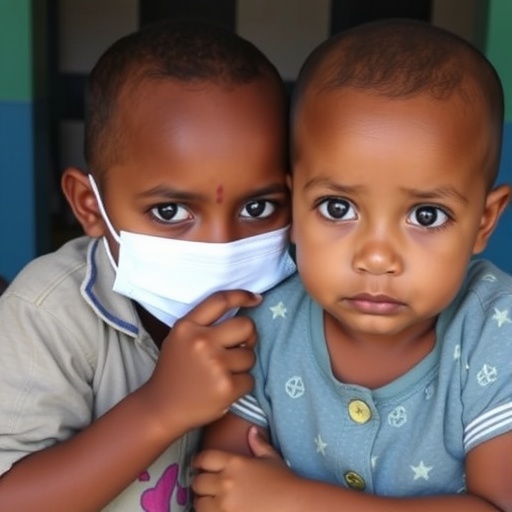
Credit: Pediatric Academic Societies
BALTIMORE – A new study aims to validate the pediatric version of Sequential Organ Failure Assessment score in the emergency department (ED) setting as a predictor of mortality in all patients and patients with suspected infection. Findings from the study will be presented during the Pediatric Academic Societies (PAS) 2019 Meeting, taking place on April 24 – May 1 in Baltimore.
In adult Sepsis-3, sepsis is defined as a Sequential Organ Failure Assessment (SOFA) score greater than or equal to 2 plus suspected infection. A pediatric version (pSOFA) was derived among pediatric intensive care unit (PICU) patients.
“Our study is the first evaluation of pSOFA and Sepsis-3 outside of the PICU setting in a broad, multi-centered cohort of children seeking emergency care,” said Frances Balamuth, MD, PhD, MSCE, one of the authors of the study. “We found that hospital mortality is a very rare outcome in this setting due to the diverse population that seek care in the ED and differentiating it from prior areas of pSOFA study. We found that pSOFA in the ED has face validity in that we observed increasing mortality with increasing pSOFA scores in both the ED population overall, and in those with sepsis according to Sepsis-3 definitions. Interestingly, we found that an ED pSOFA score of greater than or equal to 2 had poor sensitivity for predicting in hospital death, and not surprisingly had better test characteristics in those with suspected infection compared to the ED population overall.”
This study involved a retrospective observational study in seven U.S. children’s hospitals using the Pediatric Emergency Care Applied Research Network (PECARN) Registry from January 1, 2012 through -March 31, 2018. It included all ED visits for patients less than 18 years.
There were 3,087,746 ED visits during the study period. The pSOFA scores ranged from 0 to 14, with median (IQR) of 0 (0, 0). There were 88,916 (2.9%) visits with pSOFA greater than or equal to 2. Visits with pSOFA greater than or equal to 2 had increased risk of death (RR 31.8 (95% CI 28.5, 35.7) and longer median length of stay (LOS) (116 [41, 358] versus 41 [20, 85] hours, p
The study evaluated the pSOFA score in a large, multicenter sample of pediatric ED visits. The pSOFA greater than or equal to 2 was uncommon but associated with increased mortality. The pSOFA had fair discrimination for in-hospital mortality among all ED visits; and improved discrimination among patients with suspected infection.
Dr. Balamuth continued, “Because the pSOFA score incorporates laboratory values as components of the score, and many children in the ED setting appropriately do not undergo laboratory testing, the pSOFA score likely has limited utility in improving initial clinician sensitivity for mortality risk in children with possible infections. Additional risk stratification tools are needed that are specifically designed for improving sensitivity for the ‘needle in the haystack’ problem of finding pediatric severe sepsis in the emergency setting.”
Dr. Balamuth will present findings from “Validation of the Pediatric Sequential Organ Failure Assessment Score and Evaluation of Sepsis-3 Definitions in the Pediatric Emergency Department” on Sunday, April 28 at 3:30 p.m. EDT. Reporters interested in an interview with Dr. Balamuth should contact [email protected]. Please note that only the abstracts are being presented at the meeting. In some cases, the researchers may have additional data to share with media.
The PAS 2019 Meeting brings together thousands of pediatricians and other health care providers to improve the health and well-being of children worldwide. For more information about the PAS 2019 Meeting, please visit http://www.
###
About the Pediatric Academic Societies Meeting
The Pediatric Academic Societies (PAS) Meeting brings together thousands of pediatricians and other health care providers united by a common mission: to improve the health and well-being of children worldwide. This international gathering includes pediatric researchers, leaders in pediatric academics, clinical care providers and community practitioners. Presentations cover issues of interest to generalists as well as topics critical to a wide array of specialty and sub-specialty areas. The PAS Meeting will be the premier North American scholarly child health meeting. The PAS Meeting is produced through a partnership of four pediatric organizations that are leaders in the advancement of pediatric research and child advocacy: American Pediatric Society, Society for Pediatric Research, Academic Pediatric Association and American Academy of Pediatrics. For more information, please visit http://www.
Abstract: Validation of the Pediatric Sequential Organ Failure Assessment Score and Evaluation of Sepsis-3 Definitions in the Pediatric Emergency Department
Background: In adult Sepsis-3, sepsis is defined as a Sequential Organ Failure Assessment (SOFA) score greater than or equal to 2 plus suspected infection. A pediatric version (pSOFA) was derived among PICU patients.
Objective: Our aims were to validate the pSOFA score in the emergency department (ED) setting as a predictor of mortality in 1) all patients; and 2) patients with suspected infection.
Design/Methods: Retrospective observational study in 7 US children’s hospitals using the Pediatric Emergency Care Applied Research Network (PECARN) Registry from 1/1/12-3/31/18. We included all ED visits for patients 2 mg/dL).
Results: There were 3,076,500 ED visits during the study period. pSOFA scores ranged 0 to 14, with median (IQR) of 0 (0, 0). There were 88,986 (2.9%) visits with pSOFA greater than or equal to 2. Visits with pSOFA greater than or equal to 2 had increased risk of death (RR 31.8 (95% CI 28.5, 35.7) and longer median LOS (54 [IQR] vs 39 [IQR] hours, p
Conclusion(s): We evaluated the pSOFA score in a large, multicenter sample of pediatric ED visits. pSOFA greater than or equal to 2 was uncommon but associated with increased mortality. pSOFA had fair discrimination for in-hospital mortality among all ED visits; and improved discrimination among patients with suspected infection.
Authors: Frances Balamuth, Halden Scott, Scott Weiss, Michael Webb, James Chamberlain, Lalit Bajaj, Holly Depinet, Larry Cook, Norma Jean Simon, Sara J. Davies Deakyne, Robert Grundmeier, Elizabeth Alpern
Authors/Institutions: F. Balamuth, Pediatrics, University of Pennsylvania Perelman School of Medicine andChildren’s Hospital of Philadelphia, Philadelphia, Pennsylvania, UNITED STATES|H. Scott, L. Bajaj, Pediatrics, University of Colorado, Aurora, Colorado, UNITED STATES|S.L. Weiss, Department of Anesthesiology and Critical Care, The Children’s Hospital of Philadelphia, Philadelphia, Pennsylvania, UNITED STATES|N.E. Simon, E. Alpern, Pediatrics, Ann & Robert H. Lurie Children’s Hospital of Chicago, Chicago, Illinois, UNITED STATES|M. Webb, L. Cook, Department of Pediatrics, University of Utah School of Medicine, Salt Lake City, Utah, UNITED STATES|J. Chamberlain, Children’s National Medical Center, Washington, District of Columbia, UNITED STATES|H. Depinet, Cincinnati Children’s Hospital, Cincinnati, Ohio, UNITED STATES|R.W. Grundmeier, Pediatrics, Children’s Hospital of Philadelphia, Philadelphia, Pennsylvania, UNITED STATES|S.J. Deakyne Davies, Research Informatics & Analytics, Analytics Resource Center, Children’s Hospital Colorado, Aurora, Colorado, UNITED STATES
Media Contact
PAS
[email protected]




